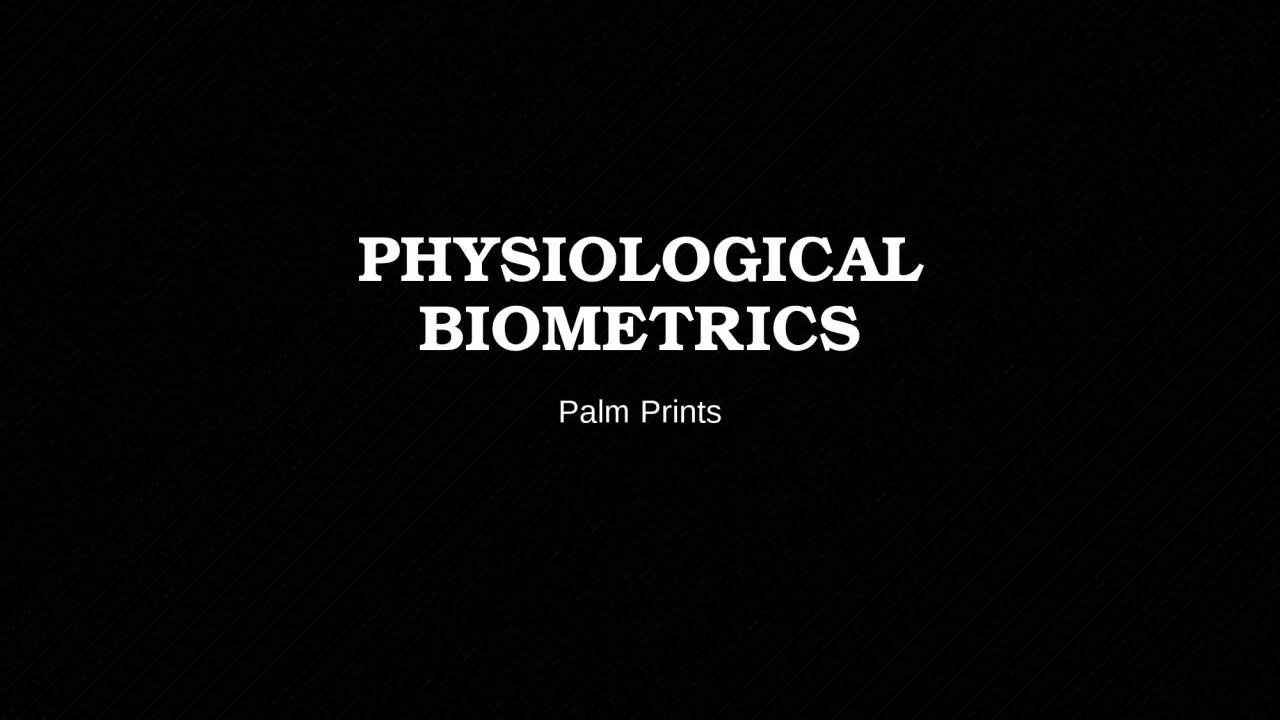

Palm Prints Features of Palm or Palm print Palm contains Three flexion creases principal lines heart line head line life line Secondary creases wrinkles Ridges Regions Finger root I inside region II and outside region III ID: 1010735
Download Presentation The PPT/PDF document "Physiological biometrics" is the property of its rightful owner. Permission is granted to download and print the materials on this web site for personal, non-commercial use only, and to display it on your personal computer provided you do not modify the materials and that you retain all copyright notices contained in the materials. By downloading content from our website, you accept the terms of this agreement.
1. Physiological biometricsPalm Prints
2. Features of Palm or Palm printPalm contains Three flexion creases (principal lines : heart line, head line, life line) Secondary creases (wrinkles)Ridges Regions : Finger root (I), inside region (II) and outside region (III)Delta point features ( center of delta – like region)Datum(end points across the palm and its mid point )Minutiae pointsGeometry features : length, width and area of palm.
3.
4. Palm print as biometricsPalm lines and wrinkles are formed during third and fifth month of development.Palm features are unique and also rich in information that can be used for feature extraction. A region of interest (ROI) is extracted from the palm area for processing.
5. Palm recognition SYSTEMPalm recognition process includes:
6. Image AcquisitionImage of palm is captured for person identification. Offline : Inked palm imagesArea of the palm (Region of interest) is “cropped” manually.Online : Palm scanners, Digital Camera (no contact)
7. Pre - processingThe principal lines, minutiae and textures are used as unique information.The pre-processing steps involve :
8. Centre of palm is used as it covers most of the palm features. To extract the centre of palm image first it has to be aligned and oriented to crop the centre portion. Many methods are used for orientation, Elliptical method : ellipse that’s fit the boundary of palm is obtained and orientation of palm is obtained by major axis of ellipse.Key Point Extraction : Valley points from middle finger, ring finger, little finger and the line joining these are taken as orientation and a centre portion of palm image is found and a circular or a squared portion of defined size is cropped.
9. Acquired imageBinary Conversion of Palm Image. Boundary trackingEstablishing coordinatesExtracting the central partPreprocessed image (ROI)
10. Feature Extraction Performed after pre-processing. Extract some stable and unique features such as principal lines, minutiae, singular points, density map, orientation field, texture etc. These extracted features can be stored in database for future verification and matching purpose.Stack filter : can extract the principal lines. Gabor filter : Effective for texture analysis.
11. Feature extractionTwo types of recognition algorithms : verification and identification.Matching methods :Line BasedSub-space Based Statistical Based Coding Based
12. Line Based approachThe line-based approach utilises edge detectors to extract palm lines.The palm lines are either matched directly or represented in other format for matching.The magnitude are projected along the x and y axis.
13. Statistical approaches Categorized into local and global statistical approaches. Local Statistical : transforms images into another domain and divide the transform into several small regions. Local statistics such as means and variances of each small region are calculated and regarded as features. Global statistical : features like moments, centre of gravity and density directly from the whole transformed images.
14. MatchingDecide whether two palm prints are from the same person or not.Palm matching techniques Minutiae-based matching : location, direction, and orientation of each minutia.Correlation-based matching : lining up the palm images and subtracting them to determine if the ridges in the two palm images correspond.Ridge-based matching : ridge pattern landmark features such as sweat pores, spatial attributes, and geometric characteristics of the ridges, and/or local texture analysis, all of which are alternates to minutiae characteristic extraction.
15. PALM PRINT : FEATURES